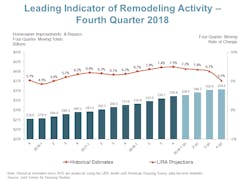Expected Gains in Remodeling Spending to Slide Lower in 2019
Annual growth in the national market for home improvement and repair is expected to slow considerably by the end of the year, according to the Leading Indicator of Remodeling Activity (LIRA) recently released by the Remodeling Futures Program at the Joint Center for Housing Studies of Harvard University. The LIRA projects that gains in renovation and repair spending to owner-occupied homes in the United States will shrink from 7.5% in 2018 to 5.1% in 2019.
“Slowing house price appreciation, flat home sales activity, and rising mortgage interest rates are deflating owners’ interest in making major investments in home improvements this year,” says Chris Herbert, managing director of the Joint Center for Housing Studies. “Continued slowdowns in homebuilding, sales of building materials, and remodeling permits all point to a more challenging environment for home remodeling in 2019.”
“Despite the growing headwinds, improvement and repair spending is still set to expand this year to over $350 billion,” says Abbe Will, associate project director in the Remodeling Futures Program at the Joint Center. “But after several years of stronger-than-average increases, the pace of growth in remodeling activity is expected to fall back to the market’s historical average annual gain of 5.2%.”
The Leading Indicator of Remodeling Activity (LIRA) provides a short-term outlook of national home improvement and repair spending to owner-occupied homes. The indicator, measured as an annual rate-of-change of its components, is designed to project the annual rate of change in spending for the current quarter and subsequent four quarters, and is intended to help identify future turning points in the business cycle of the home improvement and repair industry. Originally developed in 2007, the LIRA was re-benchmarked in April 2016 to a broader market measure based on the biennial American Housing Survey.
For more information, visit www.jchs.harvard.edu.

